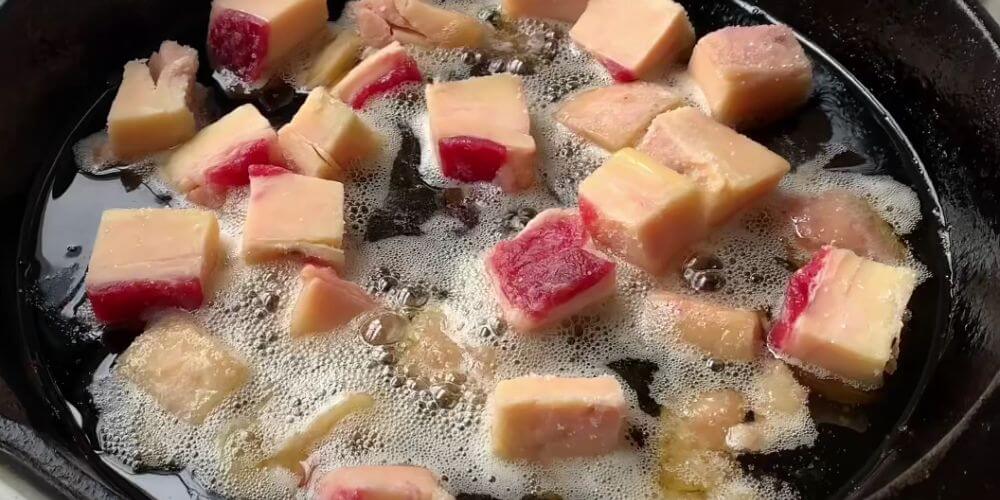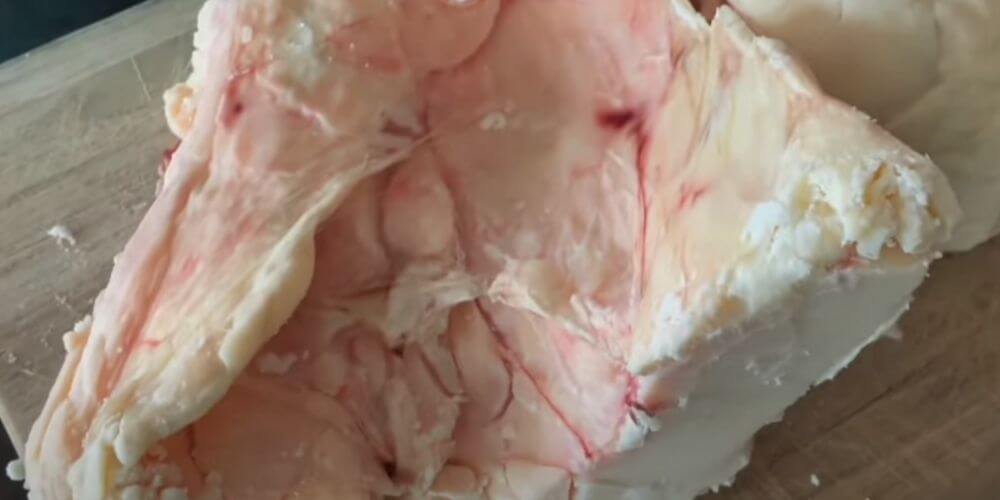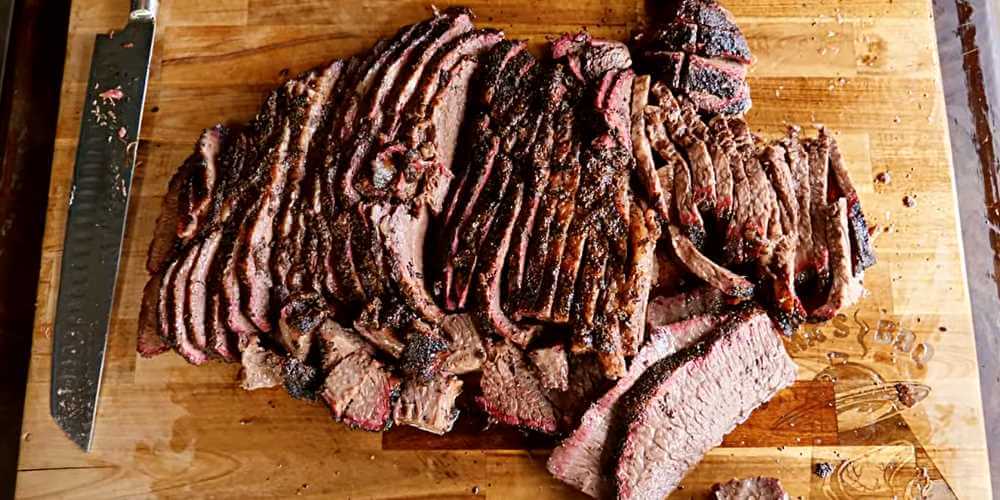We Compared Beef Tallow vs Vegetable Oil, and This is What We Found Out

Ever found yourself standing in the cooking oil aisle, grappling with the age-old dilemma of choosing between beef tallow and vegetable oil? I certainly have. The world of cooking fats is as confusing as it gets, with conflicting information and a lack of clarity leaving us pondering the perfect choice for our culinary adventures.
One day it seems healthy fats like olive oil should be used for everything. But then I hear people saying that beef tallow makes the absolute best pie crust. Conflicting information swirls about smoke points, nutrition, and even environmental impacts. So which one is better? I realised there was only one way to find out—put them head-to-head in my kitchen experiments! Join us as we delve into the realms of health, flavour, sustainability, and more, testing these kitchen staples to uncover the truth behind the sizzle.
The Lowdown on Vegetable Oil and Beef Fat
Unveiling Beef Tallow: What is it?
I hear you talking about beef tallow, and it gets my mouth watering every time! My grandma used to cook everything with it, from crispy-skinned roasts to melt-in-your-mouth pie crusts. Her kitchen always smelled like heaven, and her food had this depth of flavour you just don’t get with vegetable oils. But before you grab the nearest block, let’s explore the world of tallow with expert insight and delicious inspiration.
Tallow, rendered from cattle fat (often suet), boasts a high smoke point for high-heat cooking, adding unmatched depth and richness to dishes. Unlike popular vegetable oils, tallow possesses a unique nutritional profile. It’s rich in fat-soluble vitamins A, D, E, and K and even contains conjugated linoleic acid (CLA), linked to potential health benefits like inflammation reduction and improved fat metabolism.
Tallow, a rendered fat from cattle, has graced kitchens for centuries, but today, it shares the spotlight with vegetable oils. So, which reigns supreme? Let’s explore their distinct personalities, from smoke points to flavour profiles, and unveil the perfect culinary hero for every dish.
Vegetable Oil and The Most Common Types
Forget superhero movies; let’s talk about the real culinary chameleon: vegetable oil. This liquid gold, extracted from the humble seeds and fruits of the plant kingdom, is a kitchen staple hiding in plain sight. But what exactly is vegetable oil, and what makes it so versatile?
Vegetable oil is a culinary term for oil derived from plant sources instead of animal fats. There are many plant-based oils used for cooking and baking that are extracted from seeds, nuts, fruits, or grains.
Unlike its bolder-flavoured cousins like olive or avocado oil, vegetable oil boasts a neutral taste that lets other ingredients shine. Its high smoke point makes it a frying and baking champion, withstanding high temperatures without burning. Remember that batch of crispy fries you devoured last weekend? Vegetable oil likely played a starring role. But here’s the twist: “vegetable oil” isn’t one specific oil; it’s an umbrella term. Just like “fruit salad” can encompass a rainbow of flavours, different plant sources create entirely different vegetable oils, each with its own personality.
Some of the most popular vegetable oils include:
- Canola Oil: Made from rapeseed, it is known for its neutral taste that blends into dishes. High in monounsaturated fats.
- Corn Oil: Extracted from corn germ, it has a mild flavor perfect for frying. High in polyunsaturated fats.
- Olive Oil: Pressed from olives, it has a distinctive fruity taste. Better for low-to-medium heat cooking than frying. High in healthy monounsaturated fats.
- Sunflower Oil: Made from sunflower seeds, it has a light flavour. High in vitamin E and polyunsaturated fats.
- Soybean Oil: Extracted from soybeans, it is flavourless and versatile. One of the most affordable and common cooking oils.

Nutritional Content in Comparison
According to USDA data, vegetable oil and beef tallow have similar calorie counts, providing 886 calories per 100 grams and 902 calories per 100 grams respectively.
The key differentiation is the fat composition. While both contain a mix of saturated, monounsaturated, and polyunsaturated fats, vegetable oil has higher levels of unsaturated fats (over 80% combined) compared to tallow (around 40%). Specifically, vegetable oil contains 41.88 g of monounsaturated and 41.19 g of polyunsaturated fats per 100g serving. In contrast, beef tallow is almost 50% saturated fat at 49.8g per 100g.
Regarding micronutrients, vegetable oil far exceeds beef tallow, providing meaningful amounts of vitamin E (11.73 mg) and vitamin K (117.9 μg). Tallow only contains trace amounts of selenium and notable quantities of choline (79.8 mg).

The Great Fat Experiment: Tallow vs. Vegetable Oil
Remember Grandma’s crispy roast potatoes, golden and crackling with a flavour that transcended mere starch? Or the succulent sear on Grandpa’s steaks, kissed by smoky char and rendered beef fat? As a child, I was mesmerised by their culinary alchemy, convinced it was fueled by some secret locked away in their pantry. Little did I know, the key was in the humble fat—vegetable oil for Grandma and rendered beef fat for Grandpa.
For years, I’ve been a devout disciple of the vegetable oil aisle. Canola, peanut, avocado—you name it, I’ve slathered it on potatoes, drizzled it in stir-fries, and trusted it blindly for all my deep-frying endeavours. But after hearing my beef tallow-loving Grandpa say, “Forget those bottled wonders,” he said, “There’s a magic in rendered beef fat that vegetable oils can’t even dream of.”
Intrigued and slightly sceptical, I embarked on a quest to understand this culinary divide.
My kitchen became a makeshift laboratory, filled with bubbling pots, sizzling pans, and notebooks overflowing with scribbled observations. I pitted the humble vegetable oil against the mighty beef fat in a series of home experiments, testing their:
- Smoking points
- Flavour profiles
- Versatility
Join me as I share my learnings from the sizzling battleground of my kitchen. We’ll measure smoke points, sniff out flavour nuances, and explore the unexpected uses of both vegetable oils and beef fat. Forget culinary dogmas; this is about pushing boundaries, embracing bold tastes, and uncovering the true symphony of fat that lies within each humble ingredient.
Unmasking the Smoke Point of Your Fats
The smoke point, that elusive yet crucial number, is the temperature at which your oil or fat starts to break down, spewing smoke and unleashing a torrent of unwanted flavours. Knowing this magic number is key to unlocking deliciousness and avoiding the dreaded burn-off scenario.
Today, we’ll be pitting two titans of the kitchen battlefield: vegetable oil and beef fat. But instead of a gladiator arena, we’ll be using the shallow frying test, a simple yet effective method that will reveal their smoke point secrets.
What You Need:
- Two small pans (cast iron or stainless steel)
- Cooking thermometer
- Toothpicks
- Vegetable oil and beef fat (I used olive oil!)
What To Do:
- Heat pans over medium heat.
- Pour a thin layer of each fat into its respective pan. Enough to coat the bottom, but not for deep frying.
- As the heat rises, gently drop a toothpick into each pan.
- When the toothpick starts to smoke, it’s time to hit the pause button on your thermometer and take note of the temperature.
- The verdict: The fat that smokes later and at a higher temperature wins the smoke point battle!
Results:
So, who won? In this shallow frying showdown, beef fat emerged victorious, showcasing its high smoke point of 250°C and suitability for high-heat cooking like searing steaks or crispy potatoes, while olive oil had a smoke point of 199°C. But that doesn’t mean vegetable oil gets banished to the pantry corner. Its lower smoke point makes it perfect for gentler methods like sautéing or salad dressings.
The Blindfold Beef Fat and Vegetable Oil Flavour Test
Forget personality tests; the real way to unveil someone’s true self is through a blindfolded food adventure. Forget labels and preconceptions, because today, our taste buds are the ultimate judge in finding out if beef fat tastes better than vegetable oil and vice versa.
What You Need:
- Blindfolds
- Two simple dishes (We chose scrambled eggs and pancakes.)
- Two fats (Beef fat and Olive oil)
- Taste testers
What To Do:
- Heat each fat separately over medium heat, keeping them warm but not smoking.
- Prepare your chosen dishes (pancakes and scrambled eggs) using each fat. Ensure identical ingredients and quantities for a fair comparison.
- Blindfold your taste testers and offer them small bites of each dish, ensuring they don’t know which fat is used in each.
- Encourage your testers to focus on flavour, texture, and any unique notes they perceive. Have them discuss their observations without revealing which dish corresponds to each fat.
Results:
I couldn’t believe how wrong my first guesses were! As the blindfolds came off, my kitchen was filled with laughter and astonishment. The vegetable oil pancakes, which I’d assumed would be light and neutral, had a surprising hint of toastiness. It was like biting into a warm slice of sourdough bread, a subtle nuttiness lingering on my tongue. The beef-fat scrambled eggs, on the other hand, defied my expectations of heavy richness. Instead, they offered a delicate sweetness, almost like a whisper of caramel. Each bite was creamy and smooth, with a satisfyingly crisp edge that the oil-cooked eggs lacked.
It’s great news that we can enjoy the top flavours of Wagyu beef without paying an exorbitant amount of money! We’re now presented with different Wagyu options that we can choose from such as the Australian Wagyu. The Australian Wagyu or the Australian Kobe beef originated from the importation of Japanese Wagyu into Australia during the 1980s. The Japanese cattle were crossbred with European and British cattle to produce what is known as Australian Wagyu today. Australia is home to lush and vast pastures and has the perfect climatic conditions to raise Wagyu cattle. Today, Australian Wagyu is next in line to Japanese Wagyu and is enjoyed by most diners internationally.
The Versatility Showdown
Forget boring labels and bland expectations! Today, we’re throwing a culinary fiesta, putting up two kitchen giants against each other —vegetable oil and beef fat—in a versatility showdown
Round 1: Searing Steaks
What You Need:
- Vegetable (olive oil) oil and beef fat
- A cast-iron skillet and a juicy steak
- Food tasters
What To Do:
- Heat the skillet screaming hot, then sear the steak (or tofu) in each fat, aiming for a golden crust. Note the browning, splatter factor, and ease of cleaning. Take the temperature of each fat using the thermometer—did the beef fat reach its smoke point first?
Round 2: Baking Muffins
What You Need:
- Beef fat and olive oil
- Muffin or cookie recipe
- Mixing bowls, trays, and oven
What To Do:
- Whip up your favourite muffin or cookie recipe, using separate batches with each fat. Bake until golden, then compare textures, moisture, and overall taste. Did the vegetable oil create lighter treats? Does the beef fat add a touch of richness?
Round 3: Deep-frying
What You Need:
- Beef fat and olive oil
- Deep fryer or pot
- Potato wedges or onion rings
- Slotted spoon
What To Do:
- Heat your oil in the deep fryer or pot, then plunge the potato wedges or onion rings into each one. Watch them transform, comparing the crispness, oil absorption, and flavour. Does the vegetable oil offer a light crunch while the beef fat delivers a smoky punch?
The Results
My tastebuds just went on a wild ride. Remember that “light and fluffy” vegetable oil I used on the steak? Turns out, it delivered a surprisingly deep, caramelised sear, and the “rich and decadent” beef fat—don’t even get me started—was a smoky serenade. It painted a deep, golden crust on my steak!
Veggie oil kept things light and fluffy in the muffins, like a party with confetti sprinkles. Beef fat, though? It created a superbly moist texture but gave it an aftertaste that wasn’t exactly pleasant. For my potato wedges, the veggie oil gave my potato wedges an airy, party-in-my-mouth crunch. The beef fat levelled them up by adding a natural umami flavour and making them finger-licking good!
Tallow or Vegetable Oil: Take Your Pick
After all the sizzling experiments and flavour revelations, one thing is clear: both beef tallow and vegetable oils have a rightful place in the kitchen. Their differences in smoke points, versatility, and even nutrition profiles showcase why home cooks can benefit from keeping these ingredients in their arsenal.
While tallow might provide exceptional flavour for high-heat searing, the versatility and health benefits of vegetable oils cannot be ignored either. Finding the appropriate oil for your cooking application and taste preferences is key. Our verdict? Enjoy them both in moderation as part of a balanced diet.
We hope shining a spotlight on these oft-overlooked fats provided helpful learnings for your next culinary adventure. Whether it’s baking the perfect pie crust with beef tallow or stir-frying vibrant veggies in vegetable oil, embrace their strengths. And next time you stroll the oil aisle, see it with fresh eyes, knowing a new world of flavours awaits.
Beef Tallow FAQ
When it comes to choosing between beef tallow and vegetable oil, price is just the tip of the iceberg. While the average cost per kilogram of tallow sits at around $6, compared to vegetable oil’s $4 per litre, there’s a whole world of flavour, health, and recipe considerations waiting to be explored.
At The Meat Inn Place, Lilydale’s premier butcher shop, we understand the importance of choosing the right cooking fats to enhance the flavours of your dishes. When it comes to substituting beef tallow for vegetable oil, it’s essential to recognise that each has distinct properties and flavours that can significantly impact the outcome of your recipe. In short, it’s not a one-size-fits-all substitution.
Remember, beef tallow isn’t a direct swap for vegetable oil in baking recipes. Embrace its distinct personality! Consider adapting the recipe based on the desired flavour, fat content, and potential texture changes. You may need to melt the tallow and adjust the amounts, temperature, and time.
At The Meat Inn Place, Lilydale’s premier butcher shop, we know that the savoury flavour of tallow, rendered from beef suet, can elevate your culinary experience. With its high smoke point, tallow is a versatile cooking fat, perfect for various dishes that are not only delicious but also nutrient-rich. Here are some easy food ideas using beef fat:
- Deep-fried chicken (cooked in Tallow)
- Tallow fries
- Flour tortillas
- Beef brisket
- Wagyu burgers

